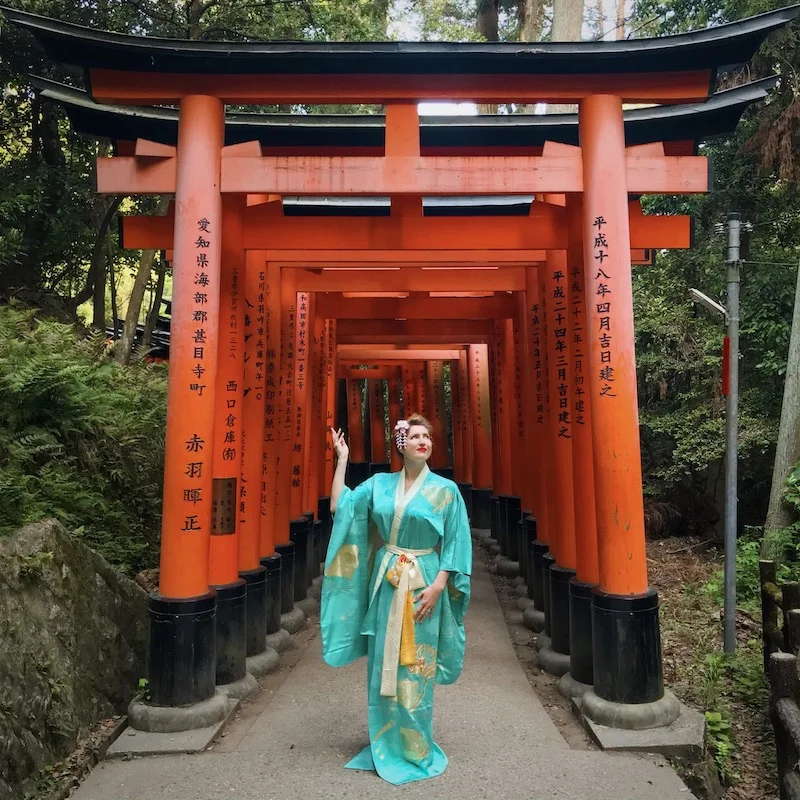Glancing through the racks and stacks of antique kimono at Gallery Kawano, it was the colour that caught my eye: a sublime aqua with a glint of gold. The silk has a subtle damask pattern of clouds, and the huge fan motifs are hand painted in shimmering gold and embroidered in gleaming metallic thread. As soon as I held her in my hands I knew I couldn’t part with her. What’s more, I knew exactly where she’d get her first outing when we hit Kyoto.
Fushimi Inari Shrine (Fushimi Inari Taisha) is famous for its thousands (literally thousands!) of glossy vermillion wooden torii gates forming winding tunnels around the forested mountainside. After another early start we arrived shortly before 5:30am - early enough for it to be almost (but not completely) free of other tourists and photographers.
Kyoto’s most important Shinto shrine, Fushimi Inari was dedicated to the god Inari in the 8th century. The shrine buildings themselves date from the late 15th century and are striking and elegant, but the it’s the torii tunnels - known as Senbon torii - behind that are the main draw for most visitors. Inari is traditionally the god of rice and sake, but is also regarded as the patron of business. In a custom which gained popularity in the Edo period (1603 – 1868), each of the torii at Fushimi Inari has been donated by a Japanese business, whose name is inscribed on the back.
We made our way along the torii-lined paths up the hillside, under the watchful eye of fox statues along the way - kitsune (foxes) are thought to serve as Inari’s messengers. It’s a surreal experience, the vermillion gloss paint causing the quality of the light to take on an orange glow. At breaks in the tunnel we emerged into forest, the brightly-painted wooden gates somehow managing to connect harmoniously with their surroundings, which struck me as a very Japanese achievement. I later learned that shortly before our visit Japan welcomed a new era, Reiwa, meaning ‘pursuing harmony’.
How to have the best experience at Fushimi Inari Shrine
If you’re planning a visit to Fushimi Inari Taisha and the Senbon Torii, here are my top tips and insights:
Opening hours: As it’s all open-air, the shrine is accessible 24 hours a day, so as long as you have transport sorted (see below), there are no constraints on when you visit. To enjoy the shrine - and get those coveted photographs of the winding tunnels, uninterrupted by other tourists - you’ll want to be there before 6am. If you get there a bit later, you can still enjoy relative peace by hiking a short distance further up the mountainside, as many visitors only make it to the lower areas. Alternatively you could time your visit for the late evening, and observe the sunset from the mountainside. Bear in mind however, that the complex is only partially lit at night, so ensure you bring a flashlight for the walk back down.
Getting there: Fushimi Inari Shrine is located just outside JR Inari Station, the second station from Kyoto Station along the JR Nara Line (5 minutes, 140 yen one way from Kyoto Station). The shrine can also be reached in a short walk from Fushimi Inari Station along the Keihan Main Line. The trains do not run 24 hours a day however, so if you are planning an early start check the timetables the day before. We took a metered taxi from our Ryokan in the old town, which cost around 2,000 Yen - we arranged it with the (slightly incredulous) receptionist the night before.
How much time to allow: We spent a good three hours or so, wandering the trail and taking photos. The hike to the summit takes around 2-3 hours, but of course you’re free to just wander as far as you feel like. It’s worth getting as far as the upper shrine though, a secondary, slightly more rustic, shrine complex with fox statues and stone altars bedecked with incense, offerings, and miniature wooden torii gates.
Terrain: It is a mountain, so expect to walk uphill, but the path is paved and the winding trail is on a fairly gentle gradient, and regular pauses for photos mean it’s not a strenuous walk.
Practicalities: There are a couple of tea houses and drinks vending machines along the route. There are also toilets near the upper shrine.
Entrance fee: Free!





















